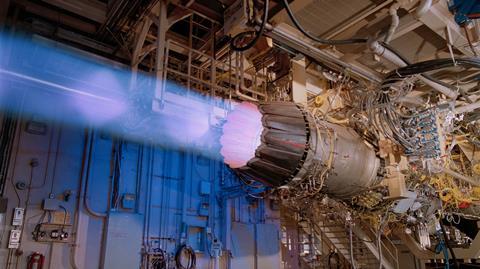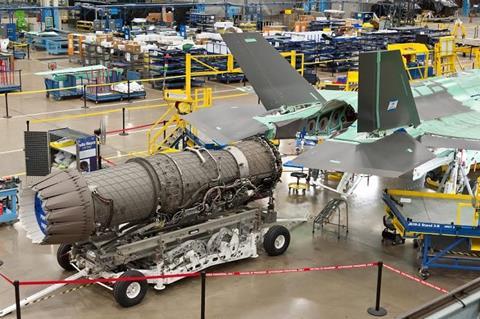Engine maker Pratt & Whitney says it is “ramping” up a programme to perform core engine upgrades on the US Air Force (USAF) fleet of Lockheed Martin F-35 fighters.
The Raytheon subsidiary and producer of the F135 engine that powers the advanced stealth aircraft has been vying for a deal with the USAF to upgrade the existing powerplant, which is approaching the tested limits of its cooling and power generation capacity.
Jennifer Latka, P&W’s vice-president for F135 engines, on 13 December said that following the recent awarding of a $115 million preliminary support contract for F-35 engine enhancement, the company is proceeding as if the programme will progress fully.
“We are on contract for [engine core upgrade], and we are ramping it as if it is never going to stop,” Latka says.
The firm now has 250 engineers working on the programme, Latka says, with milestones established for the improved powerplants to enter service by 2028.

The Engine Core Upgrade (ECU) was previously referred to within P&W as the Enhanced Engine Package (EEP). Latka says the company rebranded the programme to ECU in line with preferences of a customer – presumably the USAF.
The service has been engaged in a multi-year effort to find a solution to increase the power generation and cooling for the F-35, as onboard needs have risen with the addition of newer and more powerful sensors to the single-engined jet.
The USAF, through its Adaptive Engine Transition Program (AETP), funded the development of more advanced, entirely new engines by P&W and GE Aerospace that could replace the current F135 engine system altogether.
GE maintains AETP, in particular the XA100 engine it developed under the programme, represents the best option for the future of F-35 propulsion, saying the adaptive engine will ”maintain a competitive edge over near-peer adversaries” beyond 2028.
”GE Aerospace has developed an engine with 30% more range, 20% greater acceleration and double the thermal management capacity”, the company says, adding it could deliver the powerplants by the end of this decade.
However, in addition to its own XA101 adaptive engine demonstrator, P&W also put forward a core upgrade of the F135, now calling that package ECU, which the company says represents a cheaper and faster path to addressing the current engineering constraints.
“Pratt & Whitney is offering the [ECU] because it solves the problem and it does so in the most cost effective way,” Latka says.
Notably, the AETP engines are not compatible with the F-35Bs operated by the US Marine Corps (USMC). Both manufacturers say their adaptive engines will work on the carrier variant F-35C. Neither the US Navy, which operates the F-35C, nor the USMC have expressed interest in funding a new engine for their F-35s.
If the USAF’s F-35As were to receive a new powerplant, the Pentagon would need to develop a separate, parallel logistics chain for that distinct engine – something P&W argues represents a substantial cost increase.
“That includes the sustainment costs, the production costs and the development,” Latka says. “We believe that the core upgrade will provide $40 billion in savings to the customer.”

Funding for either contingency was conspicuously not included in the recent defence spending agreement released by congressional leaders in Washington DC. That, despite USAF chief of staff General Charles Brown saying in September the service hoped to “get through a decision this year”.
In fact, Congress appears sceptical of the entire concept; the 2023 National Defense Authorization Act (NDAA) to fund the Pentagon instead directs an audit of all “efforts to modernise the propulsion, power and thermal management systems of the F-35 aircraft”.
That report is due to Congress no later than 28 February 2023.
The current NDAA draft has already been approved by the US House of Representatives and is scheduled for a vote in the Senate later this week. It includes funding for 69 new F-35s, 38 of which are F-35As for the USAF. If passed, it will go to President Joe Biden for final approval. The addition of a major spending item, such as new F-35 engine upgrades, is unlikely so late in the legislative process.
The bill does include funding for the continued research and development of advanced adaptive engine propulsion systems under the USAF’s Next Generation Adaptive Propulsion initiative, which includes GE and P&W, as well as Lockheed Martin, Boeing and Northrop Grumman.
Latka, citing comments from USAF civilian administrator secretary Frank Kendall, says P&W is “hopeful” the matter of F-35 engine upgrades will be decided in the fiscal year 2024 military budget.
“But I do think this is a good sign that we are off and running”, she adds, in reference to the recent preliminary contract.
Story updated 14 December to include comments from GE Aerospace.



























